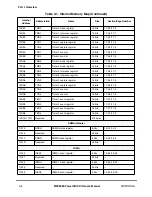
MOTOROLA
Chapter 2. PowerPC Processor Core
2-29
Part I. Overview
2.7 Instruction Timing
The processor core is a pipelined superscalar processor. A pipelined processor is one in
which the processing of an instruction is broken into discrete stages. Because the
processing of an instruction is broken into a series of stages, an instruction does not require
the entire resources of an execution unit at one time. For example, after an instruction
completes the decode stage, it can pass on to the next stage, while the subsequent
instruction can advance into the decode stage. This improves the throughput of the
instruction ßow. The instruction pipeline in the processor core has four major stages,
described as follows:
¥
The fetch pipeline stage primarily involves retrieving instructions from the memory
system and determining the location of the next instruction fetch. Additionally, the
BPU decodes branches during the fetch stage and folds out branch instructions
before the dispatch stage if possible.
¥
The dispatch pipeline stage is responsible for decoding the instructions supplied by
the instruction fetch stage, and determining which of the instructions are eligible to
be dispatched in the current cycle. In addition, the source operands of the
instructions are read from the appropriate register Þle and dispatched with the
instruction to the execute pipeline stage. At the end of the dispatch pipeline stage,
the dispatched instructions and their operands are latched by the appropriate
execution unit.
¥
During the execute pipeline stage, each execution unit that has an executable
instruction executes the selected instruction (perhaps over multiple cycles), writes
the instruction's result into the appropriate rename register, and notiÞes the
completion stage that the instruction has Þnished execution.
The execution unit reports any internal exceptions to the completion/writeback
pipeline stage and discontinues execution until the exception is handled. The
exception is not signaled until that instruction is the next to be completed. Execution
of most load/store instructions is also pipelined. The load/store unit has two pipeline
stages. The Þrst stage is for effective address calculation and MMU translation and
the second stage is for accessing the data in the cache.
¥
The complete/writeback pipeline stage maintains the correct architectural machine
state and transfers the contents of the rename registers to the GPRs and FPRs as
instructions are retired. If the completion logic detects an instruction causing an
exception, all following instructions are cancelled, their execution results in rename
registers are discarded, and instructions are fetched from the correct instruction
stream.
The processor core provides support for single-cycle store operations and it provides an
adder/comparator in the SRU that allows the dispatch and execution of multiple integer add
and compare instructions on each cycle.
Performance of integer divide operations has been improved in the processor core. A divide
instruction takes half the cycles to execute as described in the
MPC603e UserÕs Manual
.
Summary of Contents for MPC8260 PowerQUICC II
Page 1: ...MPC8260UM D 4 1999 Rev 0 MPC8260 PowerQUICC II UserÕs Manual ª ª ...
Page 66: ...lxvi MPC8260 PowerQUICC II UserÕs Manual MOTOROLA ...
Page 88: ...1 18 MPC8260 PowerQUICC II UserÕs Manual MOTOROLA Part I Overview ...
Page 120: ...2 32 MPC8260 PowerQUICC II UserÕs Manual MOTOROLA Part I Overview ...
Page 138: ...Part II iv MPC8260 PowerQUICC II UserÕs Manual MOTOROLA Part II Configuration and Reset ...
Page 184: ...4 46 MPC8260 PowerQUICC II UserÕs Manual MOTOROLA Part II ConÞguration and Reset ...
Page 202: ...Part III vi MPC8260 PowerQUICC II UserÕs Manual MOTOROLA Part III The Hardware Interface ...
Page 266: ...8 34 MPC8260 PowerQUICC II UserÕs Manual MOTOROLA Part III The Hardware Interface ...
Page 382: ...10 106 MPC8260 PowerQUICC II UserÕs Manual MOTOROLA Part III The Hardware Interface ...
Page 392: ...11 10 MPC8260 PowerQUICC II UserÕs Manual MOTOROLA Part III The Hardware Interface ...
Page 430: ...Part IV viii MOTOROLA Part IV Communications Processor Module ...
Page 490: ...14 36 MPC8260 PowerQUICC II UserÕs Manual MOTOROLA Part IV Communications Processor Module ...
Page 524: ...17 10 MPC8260 PowerQUICC II UserÕs Manual MOTOROLA Part IV Communications Processor Module ...
Page 556: ...18 32 MPC8260 PowerQUICC II UserÕs Manual MOTOROLA Part IV Communications Processor Module ...
Page 584: ...19 28 MPC8260 PowerQUICC II UserÕs Manual MOTOROLA Part IV Communications Processor Module ...
Page 632: ...21 24 MPC8260 PowerQUICC II UserÕs Manual MOTOROLA Part IV Communications Processor Module ...
Page 652: ...22 20 MPC8260 PowerQUICC II UserÕs Manual MOTOROLA Part IV Communications Processor Module ...
Page 668: ...23 16 MPC8260 PowerQUICC II UserÕs Manual MOTOROLA Part IV Communications Processor Module ...
Page 758: ...27 28 MPC8260 PowerQUICC II UserÕs Manual MOTOROLA Part IV Communications Processor Module ...
Page 780: ...28 22 MPC8260 PowerQUICC II UserÕs Manual MOTOROLA Part IV Communications Processor Module ...
Page 874: ...29 94 MPC8260 PowerQUICC II UserÕs Manual MOTOROLA Part IV Communications Processor Module ...
Page 920: ...31 18 MPC8260 PowerQUICC II UserÕs Manual MOTOROLA Part IV Communications Processor Module ...
Page 980: ...A 4 MPC8260 PowerQUICC II UserÕs Manual MOTOROLA Appendixes ...
Page 1002: ...Index 22 MPC8260 PowerQUICC II UserÕs Manual MOTOROLA INDEX ...
Page 1006: ......
















































